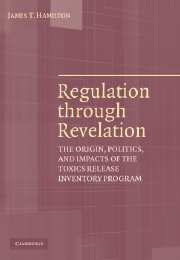 Regulation through Revelation
Regulation through Revelation Book contents
- Frontmatter
- Contents
- Acknowledgments
- Introduction
- 1 Legislating an Incomplete Contract
- 2 Defining Terms: Rulemaking and the Initial TRI Data Release
- 3 Spreading the Word in the Public and Private Sectors
- 4 Politics of Expansion and Contraction
- 5 Life Cycles in the Regulatory Environment
- 6 The Impact(s) of the TRI
- 7 Lessons from and for Regulatory Implementation
- Notes
- Bibliography
- Index
7 - Lessons from and for Regulatory Implementation
Published online by Cambridge University Press: 24 November 2009
- Frontmatter
- Contents
- Acknowledgments
- Introduction
- 1 Legislating an Incomplete Contract
- 2 Defining Terms: Rulemaking and the Initial TRI Data Release
- 3 Spreading the Word in the Public and Private Sectors
- 4 Politics of Expansion and Contraction
- 5 Life Cycles in the Regulatory Environment
- 6 The Impact(s) of the TRI
- 7 Lessons from and for Regulatory Implementation
- Notes
- Bibliography
- Index
Summary
Amassing information about information provision is like analyzing analysis. In both cases, gaps in the first stage get magnified in the second stage. Assessing the operation of the Toxics Release Inventory is difficult in part because of its originality and effectiveness. Prior to the passage of EPCRA, firms did not track many of the releases and transfers they would later have to report after this community right-to-know law passed. The toxics data companies did possess prior to 1987 did not often end up in the public domain, in part because it could invite scrutiny, liability, and regulators' attention. Charting the nationwide levels of TRI releases and transfers before the companies had to collect the data is thus infeasible. This rules out measuring the exact impact of information on toxic emissions by looking at trends pre- and post-EPCRA. Yet there are many other ways to investigate the operation and impact of the TRI. In this chapter, I first take a snapshot from the EPA's most recent release of TRI data. I next consider what lessons can be learned from the operation of the TRI as an information provision program. The chapter concludes with an assessment of general lessons for regulatory implementation.
The TRI as a Snapshot
The EPA's June 2004 publication 2002 Toxics Release Inventory (TRI) Public Data Release Report offers a snapshot of toxics in the U.S. For TRI reporting year 2002, 24,379 facilities filed 93,380 TRI forms.
- Type
- Chapter
- Information
- Regulation through RevelationThe Origin, Politics, and Impacts of the Toxics Release Inventory Program, pp. 244 - 256Publisher: Cambridge University PressPrint publication year: 2005


